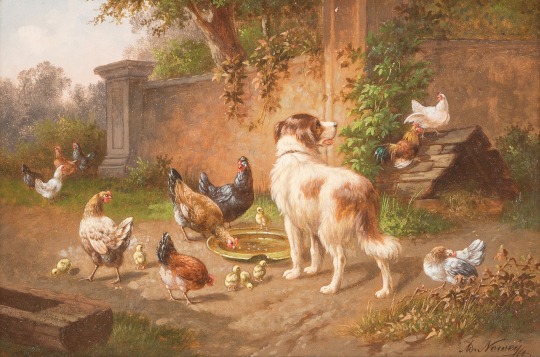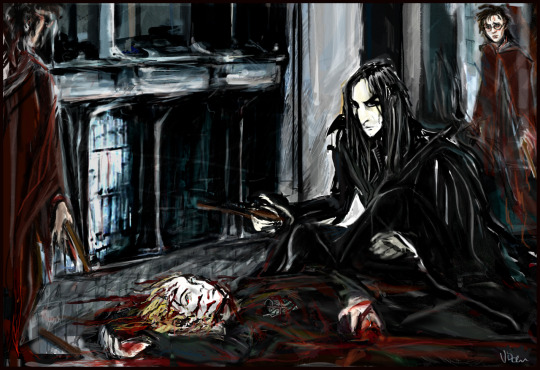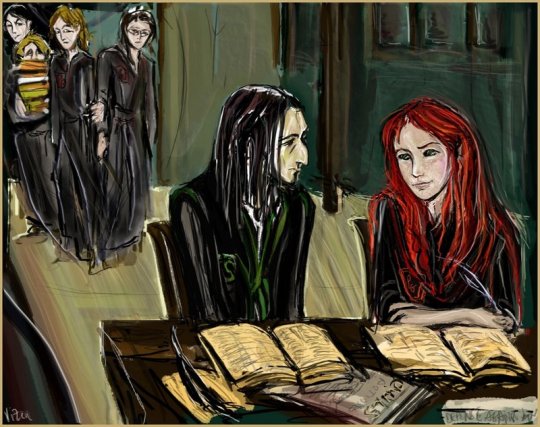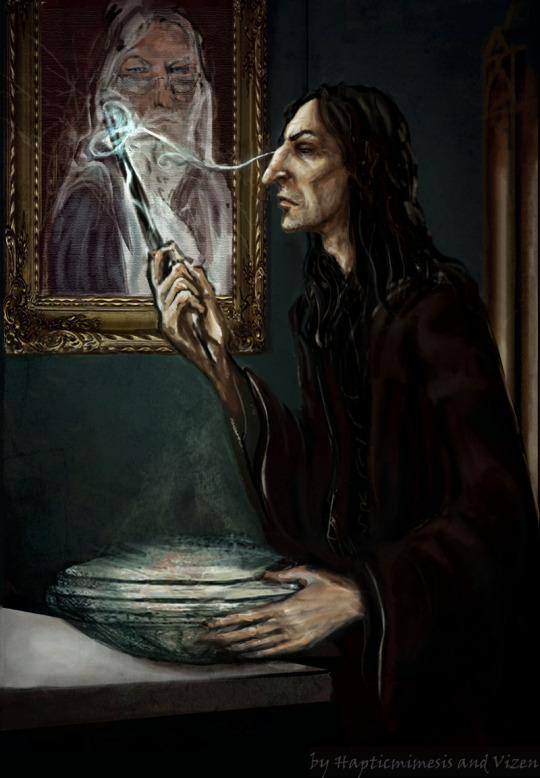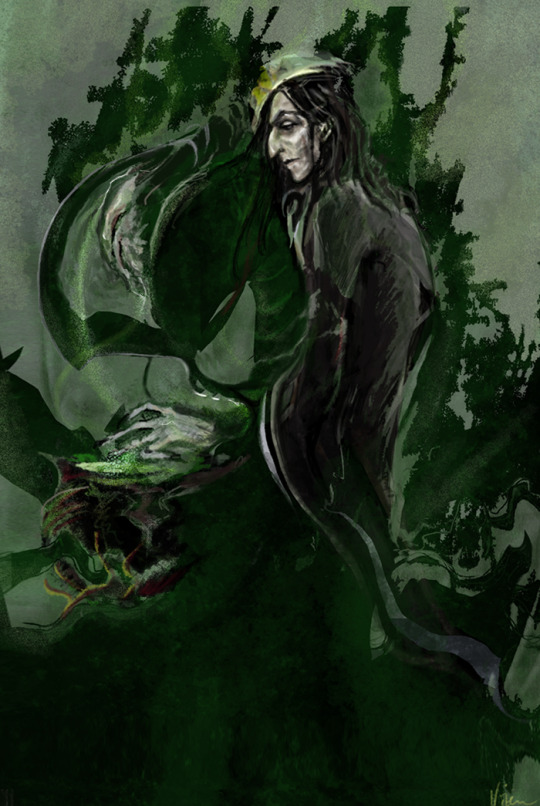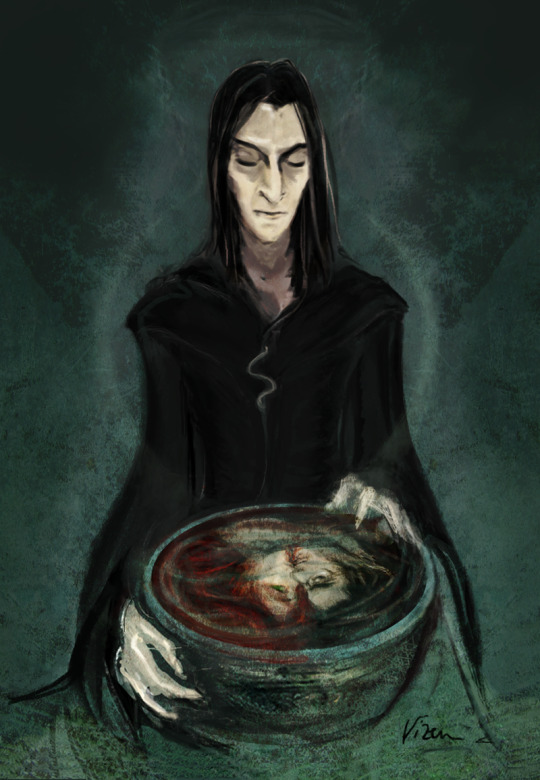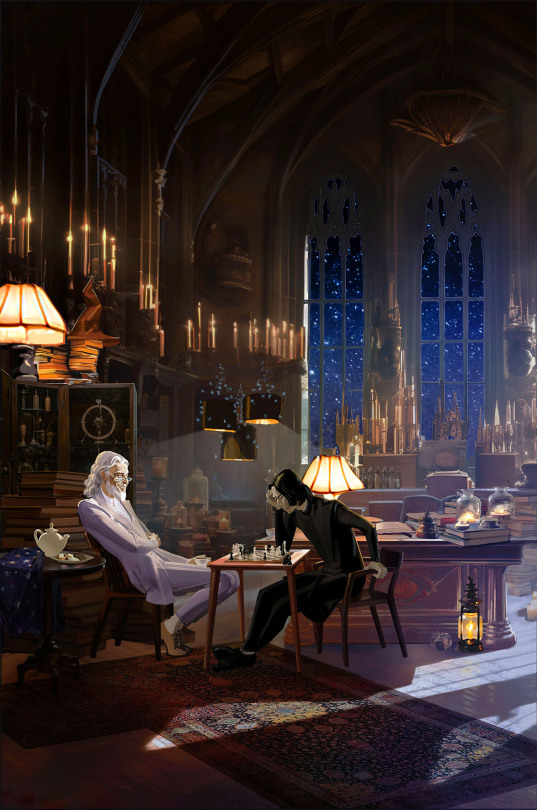Text
My Hogwarts Castle Design
Some of my notes regarding it can be found here and some of my rambling about the castle's architecture here along with the map of the castle's environment here.
In this post, I'm just going to post the images I came to as an amalgamation of all book quotes regarding the castle's structure merged with the basic structure and some floor plan elements from Hogwarts Legacy (since the castle is gorgeous and similar in aesthetic to the movies versions. I'm saying versions because every movie had a differently designed Hogwarts).
Maybe I can make a post regarding all the book quotes that went into this design like Ron saying the lake is to the south of the school (PoA), the DADA and the Transfiguration office have a view of the Quidditch Pitch (OotP, PoA) and the Quidditch Pitch is near the lake (OotP), the lawn for the flying classes is on the opposite side of the grounds to the Forbidden Forest (PS) and the Whomping Willow is visible from the Herbology Greenhouses (CoS), the moving staircases aren't accessible from the ground floor near the Great Hall (PS), Myrtel's bathroom near the DADA office (CoS), hidden passage with the trick step being near the DADA office on the 2nd floor (location mentioned in HBP, but the passage itself is mentioned in multiple books), etc.
So without further ado, my attempt at a Hogwarts floor plan:
There might be some inaccuracies, becouse this was a crazy puzzle to try and make sense of so I tried my best based on various quotes in the books. Locations we know exist but aren't told anything about where they are, were just placed down where I thought reasonable.
I kept the common rooms/dormitories layout similar to that in Hogwarts Legacy (since it's pretty), but I made sure all of them would have enough dorm rooms and bathrooms (which isn't the case in the game).
(I hope my calligraphy is legible enough. I advice zooming in if you want to read all the details on the images)
Dungeons:
Left - Lower Dungeons, Slytherin's Common Room.
Right - Dungeons, Potions Labs, Snape's office, Detention Chambers, the obstacle course under Fluffy's room.

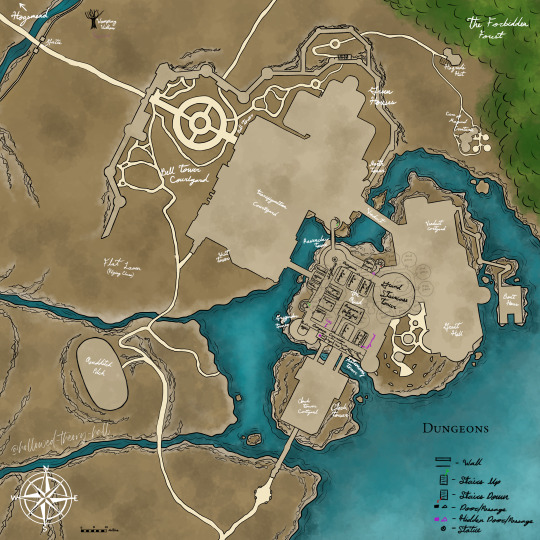
Basement
Left - Actual Basement - Kitchens, Hufflepuff Common Room.
Right - Half floor between Basement and Ground Floor - Hufflepuff Girls Dorms.
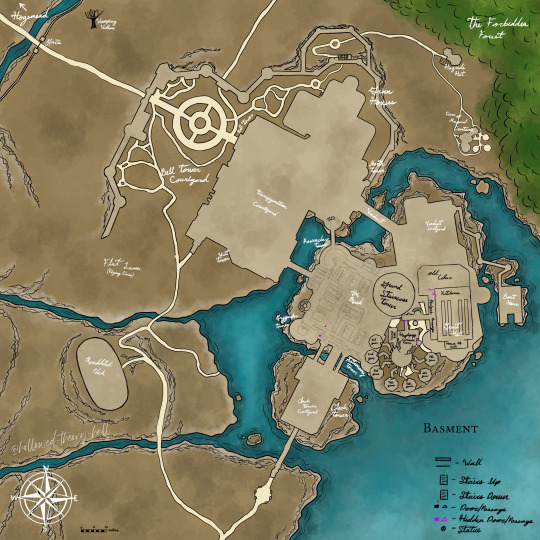
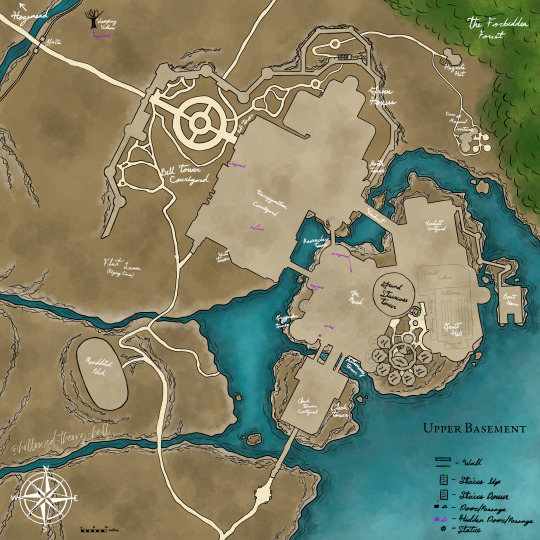
Ground Floor
Entrance Hall, Great Hall, Staff Room, Filch's office, Viaduct Courtyard.

1st Floor
Classrooms 1-15, Hospital Wing, Viaduct, Greenhouses, DADA classroom, History classroom, Muggle Studies classroom.
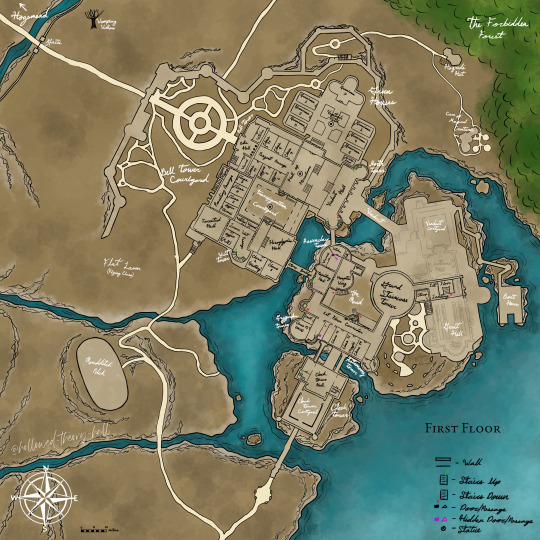
Classroom 11 is said to be on the ground floor, but I placed it on the 1st floor, which is technically the ground floor of the second building. It just worked better with everything else.
2nd Floor
Classrooms 1B-15B, Transfiguration classroom, Ancient Runes classroom, DADA office, Moaning Myrtle toilet.

3rd Floor
Classrooms 1C-11C, Fluffy's room, Charms Corridor, Charms Classroom, Trophy Room, Armor Gallery, Library.

I tried to make the scene in which they accidentally run into Fluffy's room after the Trophy Room, and I think this sort of works for what Harry describes if you squint. The description just doesn't make much sense when trying to keep the general structure seen in the movies/games.
4th Floor
Classrooms 1D-8D, Restricted Section.

5th Floor
Classrooms 1E-5E, Ravenclaw Common Room entrance, Prefect's bathroom, Arithmancy Classroom.
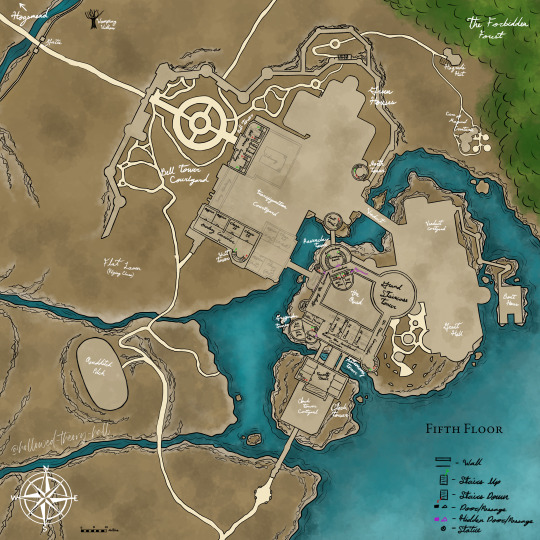
6th Floor
Classrooms 1F-2F.

7th Floor
Classrooms 1G-2G, Gryffindor Common Room entrance, Divination Classroom, RoR.
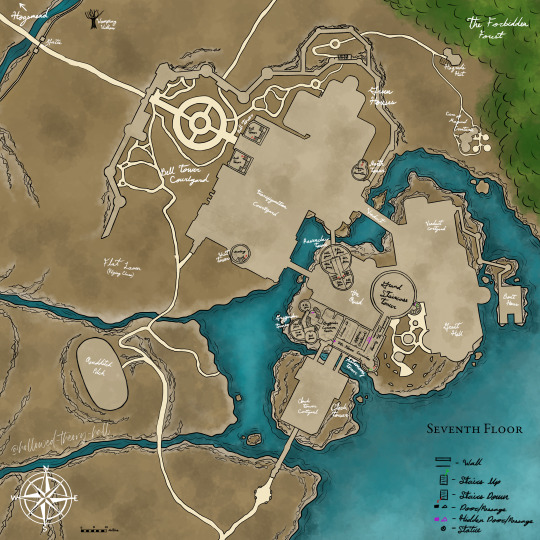
Towers
Left - Floor 8 - Headmaster's Office, Owlery
Center - Floor 9
Right - Floor 10 - Astronomy Tower



162 notes
·
View notes
Text
About Hogwarts Castle's Architecture
I think the history is wrong... Like, stone castles only became a thing in Britain when the Normans brought the practice over with them from France (Norman rule was officially established in 1066). And the first stone castles in Scotland were only built around the 1100s. Hogwarts was built around the 990s... so what's up with that?
(Like, there were some fortified stone structures in Scotland pre-normans (brochs), but no one would really call them a typical castle. Also, they were built in the Iron Age (Brochs were specifically built between 400 BC and 200 AD), so not the founders' times)
Also, many of the architectural details of Hogwarts in the movies/Hogwarts Legacy/any other video games/illustrations have much later influences, what with the Gothic architecture (which only came around in the 1200s) and elements from Victorian restored castles (I'll go more about what this means later).
And I have a Watsonian theory/headcanon to make it make sense.
What I think, is that the Hogwarts castle we (and the characters) experience, has been heavily reconstructed over the past thousand years. So Hogwarts likely started as a simpler, wooden structure (as was common in Scotland around the 10th century) and it changed and grew and evolved throughout the centuries.
So we'll walk through the history of castle architecture in Scotland and explain how Hogwats evolved over the years. (Becouse I'm an architecture and history nerd, sue me).
Pre Founders
Hogwarts is legend to have been built where the founders found a pensive:
The Hogwarts Pensieve is made of ornately carved stone and is engraved with modified Saxon runes, which mark it as an artefact of immense antiquity that pre-dates the creation of the school. One (unsubstantiated) legend says that the founders discovered the Pensieve half-buried in the ground on the very spot where they decided to erect their school.
(Pottermore)
So, the location probably wasn't empty, but had some evidence of past wizarding residence there. How much is unclear, but it was a place magic was practiced in before the founders.
990s
Hogwarts is founded as a school and sanctuary. Muggles at the time didn't really believe in witchcraft (the church considers believing in witchcraft heresy). So, it's not really to protect themselves together, but more to allow wizards to build a united community.
There is an element of hiding magic from muggles:
Why didn’t we choose to produce flying barrels, flying armchairs, flying bathtubs – why brooms? Shrewd enough to see that their Muggle neighbours would seek to exploit their powers if they knew their full extent, witches and wizards kept themselves to themselves long before the International Statute of Wizarding Secrecy came into effect.
(Quidditch Through the Ages)
But it's not for the same reason as the later witch hunts. At this time, people who confessed to witchcraft would need to repent (not via execution, mind) because they'd be seen as delusional. After all, magic doesn't exist according to church doctrine at the time. and as mentioned in the book, the concern was to be bothered to help muggles with everything, not because they were hunted at the time.
Around this time there is the magical government in England at least, is the Wizard Council, also known as the Wizengamot. Due to the similar name, the muggle Wittengamot (the council of lords that chose the king of England) might be aware of their wizard equivalent, but they might also be completely unaware (explained in the next section).
Castles, in this time period in the UK, looked something like this:
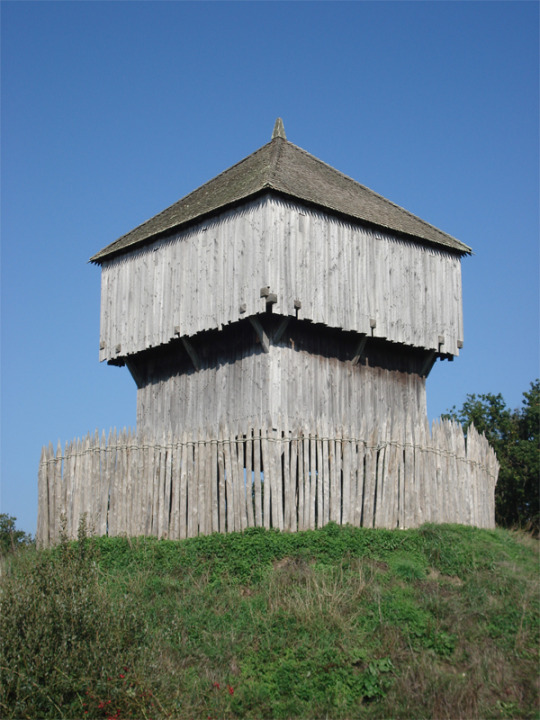

Hogwarts, when founded, probably looked like this combination of buildings and not what we imagine as a castle.
with the Chamber of Secrets as a basement. It's canon that a Gaunt later added the pipe entrance from the bathroom, so it's original entrance lay elsewhere.
Note that this means it wasn't the founders who but the Common Rooms, Room of Requirement, or the moving staircases and that the in-universe history books are wrong.
Since Hogsmeade was founded by Hengist of Woodcroft who was a student of Helga Hufflepuff when she was alive, the village was probably founded in the century following the school's founding.
1000s-1100s
Here we get the Norman Conquest of England, and while Scotland wasn't Norman, the culture in Scotland was influenced by the changes down south. Specifically, castle architecture is something they copied from the Normans.
The reason I mentioned earlier the muggle Witengamot might've not been aware of the wizarding community is because we know William brought with him wizards in his army, like the Malfoys:
Like many other progenitors of noble English families, the wizard Armand Malfoy arrived in Britain with William the Conqueror as part of the invading Norman army. Having rendered unknown, shady (and almost certainly magical) services to King William I, Malfoy was given a prime piece of land in Wiltshire, seized from local landowners, upon which his descendants have lived for ten consecutive centuries.
(Pottermore)
But many other pureblood wizard family names we can date back to the Norman invasion. Such as: Lestrange, Peverell, Wealey, Gaunt, etc. So, it's somewhat implied William won England with the help of wizards that the local Anglo-Saxon English didn't have fighting with them.
Due to these Norman wizards clearly getting positions of influence in the wizarding community (talked a bit more about this here[]), it's likely they or even William himself wanted to improve Hogwarts to keep the wizardibg population onside.
So, around the later 1000s or early 1100 Hogwarts would've looked something like this:



So, basically, the same structure as before, but the keep (where the Great Hall is, is built from stone. The Great Hall (AKA the most defensible place in the castle everyone fell back to in the Battle of Hogwarts) was the first built.
As for the inside:


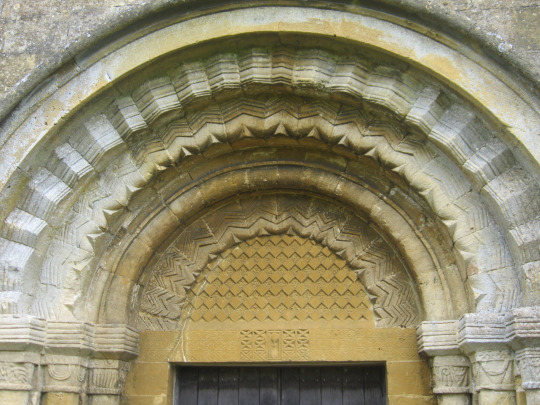
We have geometric details on the columns and archways (which are round, it's not yet the pointed gothic arches we all know and love). The walls would all be painted white and then colorful and vibrant colors over it (somewhat visible in the picture on the left).
1200s-1300s
Throughout the next two centuries, more and more wings would be added to the castle. Many of the classrooms and dorms that were outside the keep in the outer buildings moved to these new wings inside the main stone castle. The outer walls & fortifications would also be improved and extended from the former ones and a proper gatehouse would likely be built:
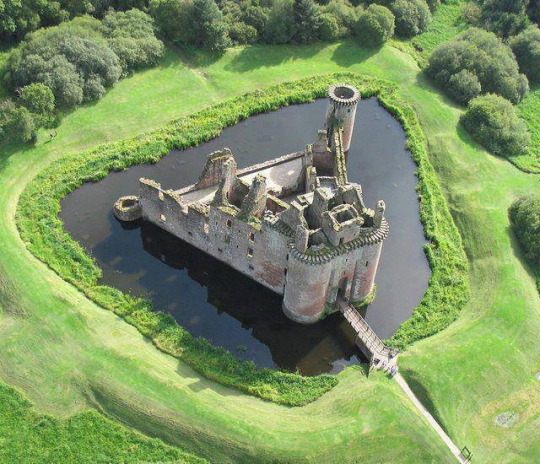

And a few churches, since they tended to be more decorated on the outside and I want to explain this is when gothic architecture was a thing and that most of the styles we recognize for castles are from this period:



This is when the Room of Requirement, the moving staircases, the towers (the Astronomy Tower, the Headmaster's Tower, and perhaps the Owlery), and the various common rooms would be built.
(Note the castle on the left would've likely had a whitewash on all of the exterior back in the day)
At this point, the Great Hall, and the quad if we think of the typical Hogwarts castle would be built:

(Image from Hogwarts Legacy)
There would be no transfiguration courtyard area yet and no clocktower yet as they are likely later additions.
I'd also note the inside of the castle, would look something like this at this point:
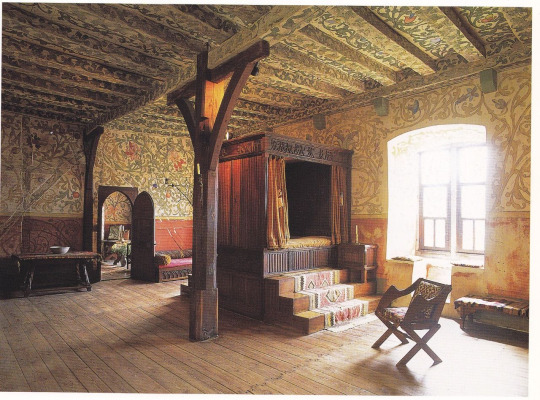


The walls would be painted and colorful and vibrant. You might also see wall hangings like we see in the Gryffindor Common room in the movies, that's actually accurate (the wall tapestry/curtain things, not the furniture, the furniture is 17th and 18th century) except the stone would likely not be bear stone and instead have a whitewash over it and tapestries over the whitewashed stone. Bear stone wasn't an all that common look in this era unless they used pretty stones that were meant to be shown off (which was expensive, hence rare).
1500s-1600s
This period is still building in a style called Gothic (12th to 16th century), but we're adding more intricate detail, and the style for furniture changes quite drastically (because we've entered the Tudor area). I believe that around the 1500s and the 1600s, more wings were added, like the clocktower, the transfiguration courtyard, and the viaduct (a bridge was probably there before, but I think it was rebuilt with the new building):

The style of buildings we're looking at now would have this sort of exterior:
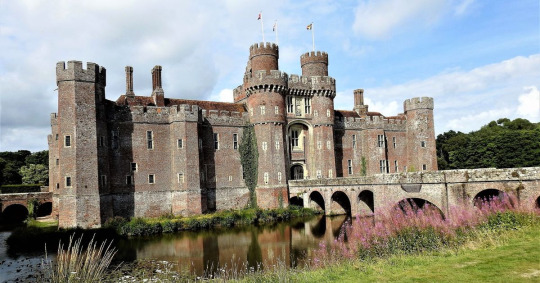
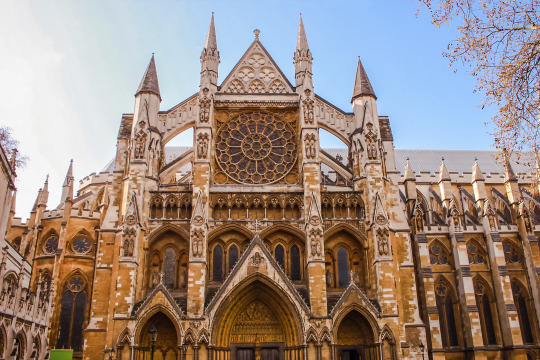

(Note the house on the left and castle on the white would've likely had a whitewash on all of the exterior back in the day)
And this is the interior we're talking about:
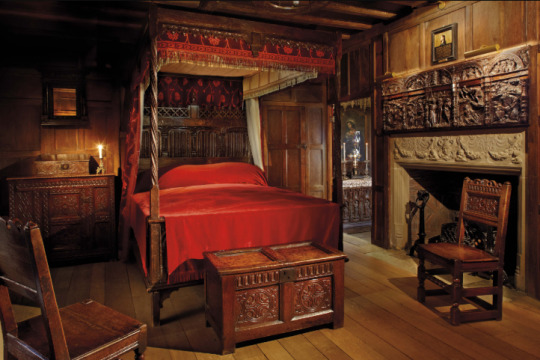
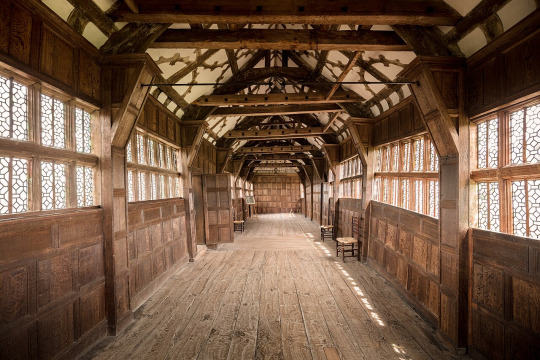
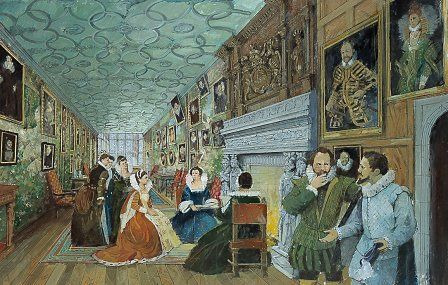
Also, up until this point, greenhouses weren't really a thing (at least not the glasshouse variety). I assume there was an Herbology Garden or that perhaps a Vegetable Patch Harry mentions exists next to the greenhouses and served as the place where they grew plants because glasshouses like we think of when we read the word "greenhouse" were only started being built in England late in the 16th century. So the Greenhouses are likely a 17th-century addition since the wizards probably adopted them a little later than the muggles.
1700s
This is when indoor plumbing was introduced to Hogwarts and the entrance to the Chamber of Secrets was changed:
When first created, the Chamber was accessed through a concealed trapdoor and a series of magical tunnels. However, when Hogwarts’ plumbing became more elaborate in the eighteenth century (this was a rare instance of wizards copying Muggles, because hitherto they simply relieved themselves wherever they stood, and vanished the evidence), the entrance to the Chamber was threatened, being located on the site of a proposed bathroom. The presence in school at the time of a student called Corvinus Gaunt – direct descendant of Slytherin, and antecedent of Tom Riddle – explains how the simple trapdoor was secretly protected, so that those who knew how could still access the entrance to the Chamber even after newfangled plumbing had been placed on top of it.
(Pottermore)
1800s
Now, back to what I mentioned in the opening paragraph about Victorian castle reconstruction. So, during the Victorian era, many rich people bought castles to restore and preserve them. Victorians in England were kinda obsessed with the Medieval period (and Ancient Egypt, but we're not talking about that right now) so they wanted to be able to walk around castles, and they had a lot of castles in the UK that fell into disrepair and just stood there empty. The thing is, the Victorian people who restored castles had no idea what Medieval castles actually looked like in the Medieval period. So all the castles you see with this sort of interior (which are most reconstructed castles, btw):
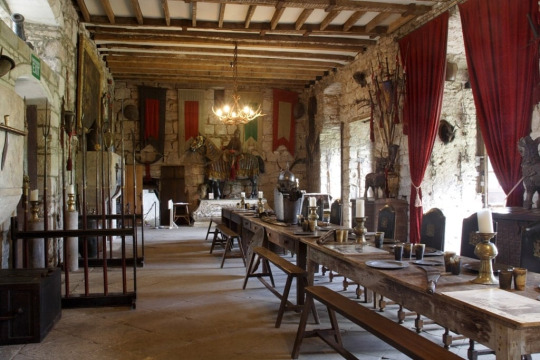
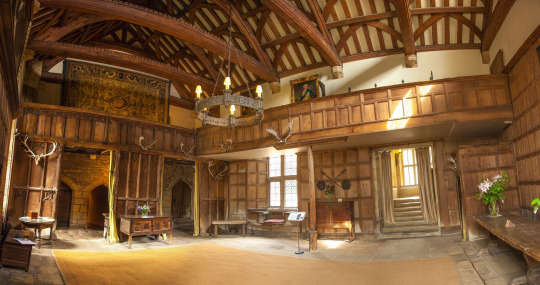
That's a Victorian reconstruction. They built how they imagined medieval castles looked like according to their own tastes and aesthetics and what they saw from more recent Todur castles, not how medieval castles actually looked like.
That being said, Hogwarts was continuously used throughout all these years, so I imagine some of these Victorian elements would make their way in, but not to the same level as these reconstructions.
Basically, different locations in the castle would look different depending on when they were built. Most furniture is likely to have been replaced more recently and would at most date back to the 1500s. So, we'll see a lot of dark wood furniture that isn't painted the way they would've painted furniture in the medieval period.
I'd also expect that some of the older walls/ceilings are still painted very vibrantly (which fits with the wizard's sense of style overall).
Basically, I think the Hogwarts we experienced in the books wasn't built in one year as a monolith by the founders. It was added to over time. Rooms that look older Medieval, and ones that look like a Tudor addition would all exist within the same castle. Areas in the older sections would have 18th-century wooden paneling because reconstruction was needed. I personally think that's the right way to go about designing Hogwarts since most castles in Britain are like that (and in the rest of Europe).
Castles changed and grew according to the needs of whoever lived there at the time and the technology available. And since, well, at some point castles weren't needed as fortified structures anymore, they lost fortifications for aesthetics. We have no surviving castles that actually look the way they did back when they were built. All the preserved ones had wings added, walls paneled with wood, and the windows replaced. And in many of them, you can actually see the patchwork in the bricks, the window style changing from one window to the next across a single wall. I think that's part of what makes castles gorgeous and it always made sense to me Hogwarts was like that too.
90 notes
·
View notes
Text
Wizarding clothing and fashion
This meta/list of HCs has been sitting in my drafts for a while. But here is my meta about wizarding fashions.
1.0 An insular culture with its own unique dress
No shade to people who enjoy seeing and drawing characters in muggle clothing, but I think that the majority of wizards and witches dress in wizarding clothing.
Indeed, the fact that most wizards can’t dress as muggles and are quite conspicuous is mentioned in the first chapter of the series:
“People in cloaks. Mr. Dursley couldn’t bear people who dressed in funny clothes — the getups you saw on young people! He supposed this was some stupid new fashion.” PS
And then becomes a sort of running joke:
“Both were dressed as Muggles, though very inexpertly: The man with the watch wore a tweed suit with thigh-length galoshes; his colleague, a kilt and a poncho” GoF
And in DH it is (partly) how Harry recognises that people are watching Grimmauld Place:
“The lurkers were never the same two days running, although they all seemed to share a dislike for normal clothing. Most of the Londoners who passed them were used to eccentric dressers and took little notice, though occasionally one of them might glance back, wondering why anyone would wear such long cloaks in this heat.” DH
Side note: it is peak Londoner to barely take notice of something odd. And this also implies that robes and cloaks are all year wear and that wizards potentially don’t have seasonal clothing.
Given that wizarding culture is very insular (with its own economy, government, and education system), it would make sense that while it may occasionally borrow trends from the muggle world, wizarding fashion and clothing are unique.
In fact, only the younger generation are seen in muggle dress, with Harry commenting:
“Their children might don Muggle clothing during the holidays, but Mr. and Mrs. Weasley usually wore long robes in varying states of shabbiness.” GoF
2.0 Class and generational differences in dress
The previous quote demonstrates two things: much like in real life, there is generational and class stratification of dress. The condition and quality of wizarding clothing serves as a non-verbal cue about a character's economic status. This disparity is not just a background detail but is frequently brought into focus, such as through Draco Malfoy's derisive comments about Professor Lupin's tattered robes.
“ Malfoy gave Professor Lupin an insolent stare, which took in the patches on his robes and the delapidated suitcase.” PoA
“Look at the state of his robes,” Malfoy would say in a loud whisper as Professor Lupin passed. “He dresses like our old house-elf.” PoA
Even Harry comments on his robes and observes that:
“Professor Lupin looked particularly shabby next to all the other teachers in their best robes”
The patched and frayed nature of both Lupins and Weasley’s robes seem to indicate that robe repairs can’t be done by an individual (or when it is done, it is really visible). Another example of this is when Ron removes the lace from his dress robes and leaves:
“...the edges still looked depressingly frayed as the boys set off downstairs.” GoF
Additionally, in Padfoot returns Sirius’s prison robes still appear tatty despite him having had a haircut and left the country. This indicates that he either can’t obtain new robes or can’t/hasn’t bothered repairing his Azkaban robes.
This is interesting, given that Molly Weasley is able to make jumpers and scarves yet can’t seem to alter robes. While knitting and sewing are separate skills, it seems odd that there aren’t means of repairing robes.
This suggests that robes can only be repaired and bought at official vendors such as Madam Malkins/Gladrags/Twifitt and Tattings.
It is also interesting that both Fred and George buy clothing when they become successful (also a parallel to the real world). They gift their mum:
“….a brand-new midnight blue witch’s hat glittering with what looked like tiny starlike diamonds, and a spectacular golden necklace.” HBP
However, things being ‘frayed’ aren’t always an indication of poverty. Tonks is first introduced wearing an outfit that is a mix of muggle clothing but with something that is distinctly wizarding:
“Tonks stood just behind him…. wearing heavily patched jeans and a bright purple T-shirt bearing the legend THE WEIRD SISTERS.” OoTP
This outfit is heavily reminiscent of Sirius and James in the Elvendork prequel:
“Both were dressed in T-shirts emblazoned with a large golden bird; the emblem, no doubt, of some deafening, tuneless rock band.”
3.0 The underwear question
Something that gets bought up a lot is whether wizards wear underwear.
Harry (who was raised by muggles certainly seems to):
“He was just piling underwear into his cauldron when Ron made a loud noise of disgust behind him.” GoF
And:
“He was shivering now, his teeth chattering horribly, and yet he continued to strip off until at last he stood there in his underwear…” DH
So does Neville (in the UK, Pants means underwear)
“He broke off as Neville entered the dormitory, bringing with him a strong smell of singed material, and began rummaging in his trunk for a fresh pair of pants.”
And infamously, so does Snape:
“Snape was hanging upside down in the air, his robes falling over his head to reveal skinny, pallid legs and a pair of graying underpants.”
Also we get some information about witch’s underwear from Sirius’s very Freudian joke:
“Sirius looked slightly disconcerted for a moment, then said, “I’ll look for him later, I expect I’ll find him upstairs crying his eyes out over my mother’s old bloomers.”
Bloomers are a type of historical, baggy underpants (think boy shorts, but make it victorian).
In conclusion, Archie, who wanted a breeze around his privates, was probably an outlier.
4.0 Materials and accesories
So what is wizarding clothing made of?
For robes and cloaks the materials most mentioned are silk/satin and velvet:
“ She was dressed from head to foot in black satin, and many magnificent opals gleamed at her throat and on her thick fingers.” GoF
Additionally in GoF, we learn that even witches and wizards from other countries wear robes and cloaks:
“Now that they had removed their furs, the Durmstrang students were revealed to be wearing robes of a deep bloodred.”
And
“...Bulgarian minister loudly, who was wearing splendid robes of black velvet trimmed with gold.”
Other materials include Dragon hide which appears to be used to make practical gloves and boots but also fashionable jackets.
“... followed by Fred and George, who were wearing jackets of black dragon skin.” HBP
Additionally, robes can be embroidered:
“ The man’s scowling, slightly brutish face was somehow at odds with his magnificent, sweeping robes, which were embroidered with much gold thread” DH
“Harry glimpsed Slughorn at the head of the Slytherin column, wearing magnificent, long, emerald green robes embroidered with silver” HBP
“Madam Rosmerta scurrying down the dark street toward them on high-heeled, fluffy slippers, wearing a silk dressing gown embroidered with dragons.” HBP
Interestingly, both men and women appear to wear heels:
Dumbledore:
“He was wearing long robes, a purple cloak that swept the ground, and high-heeled, buckled boots” PS
Madame Maxine:
“Then Harry saw a shining, high-heeled black shoe emerging from the inside of the carriage..” GoF
Monsiour Delacour:
“However, he looked good-natured. Bouncing toward Mrs. Weasley on high-heeled boots, he kissed her twice on each cheek, leaving her flustered.” DH
Madame Rosmerta:
“ Next he saw another pair of feet, wearing sparkly turquoise high heels,” POA
Furthermore, witches carry handbags:
“Mrs. Weasley now came galloping into view, her handbag swinging wildly” COS
“ She was wearing a thick magenta cloak with a furry purple collar today, and her crocodile-skin handbag was over her arm.” GoF
“Professor Umbridge pulled a small roll of pink parchment out of her handbag” OoTP
“Ron was rummaging through the little witch’s handbag.” DH
5.0 My HCs
When I imagine what male robes look like, I imagine something akin to a Morrcan thobe or an Indian Sherwani.

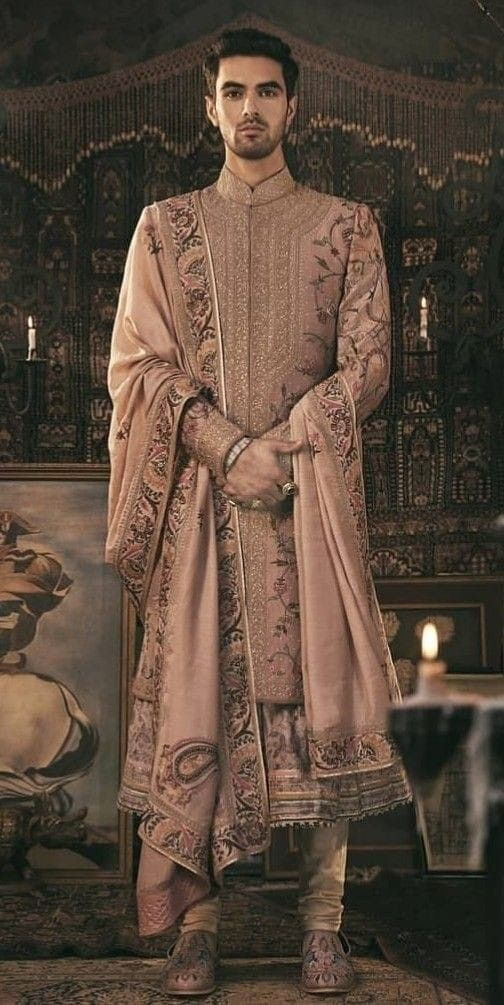
I imagine robes to be enchanted to move and in my fic Pietas, I describe my OC Aeliana’s robes as follows:
“She smiled slightly, smoothing the front of her dress, which was decorated with embroidered flowers and birds that had been enchanted to flutter their wings.”
I also HC some cultural variance in robes- with certain countries using different cloth or the skin of magical animals that are native to their countries. With hotter countries, having lighter robes and cooling/anti-perspiration charms.
444 notes
·
View notes
Text
I shared this before from the studios in London. Here is a complete painting in better quality…. I think he really deserved a portrait of his own.

2K notes
·
View notes
Note
Gay /pos /hj
which part is the half-joke the gay part or the pos part. my friend hannah wants to know
17K notes
·
View notes
Text

I drew this when I was in a deep state of sadness and depression. It raises a big question: does creating sad art help in dealing with negative emotions? On one hand, this kind of creativity allows me to pay attention to my feelings, to experience them, and to dedicate time to them without rejecting them. On the other hand, creating such a piece is a lengthy process, and at that time I was just learning to use a graphics tablet. I remember that it was really hard for me to finish this work—I had almost no energy left by the end. Take care of yourselves!
601 notes
·
View notes
Photo
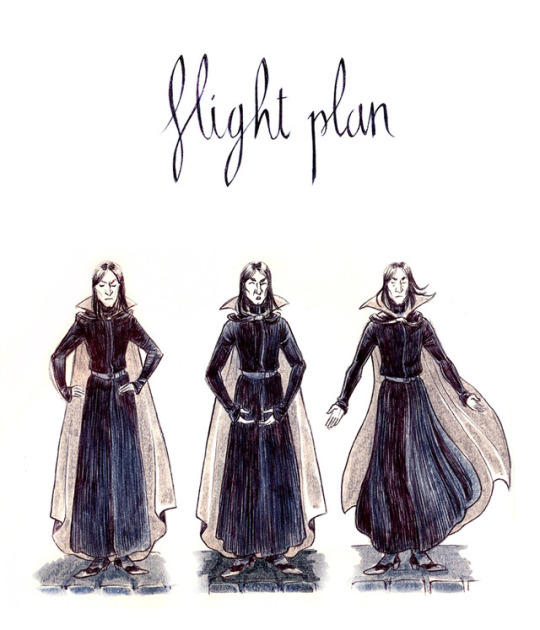

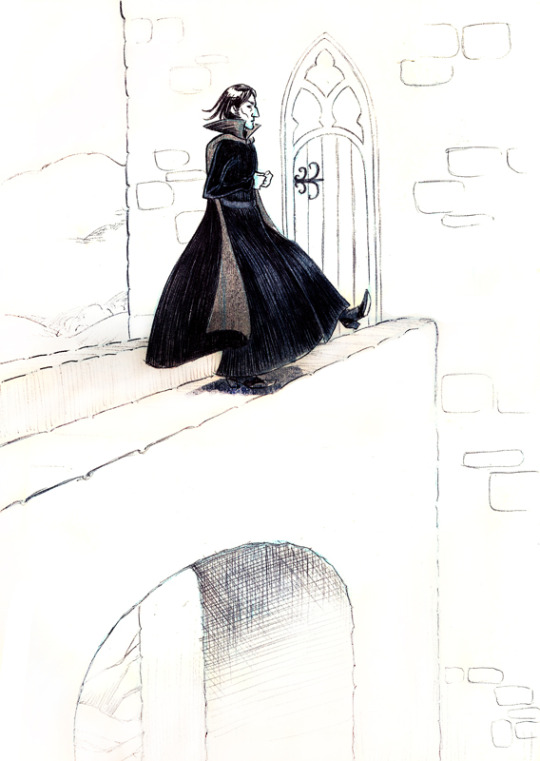

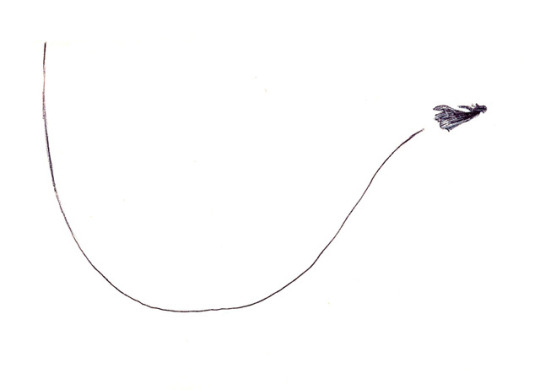
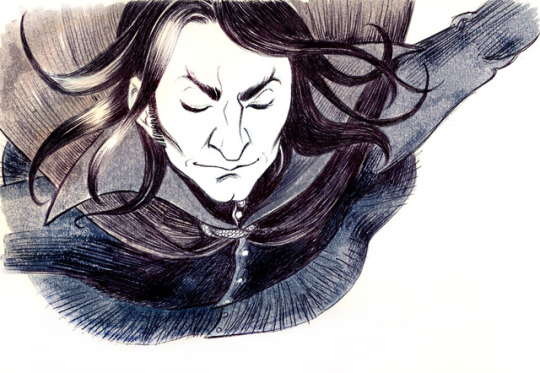

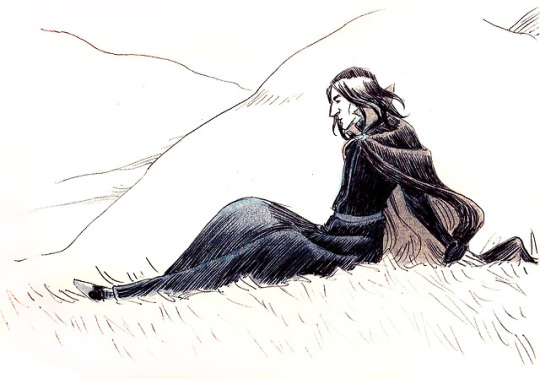

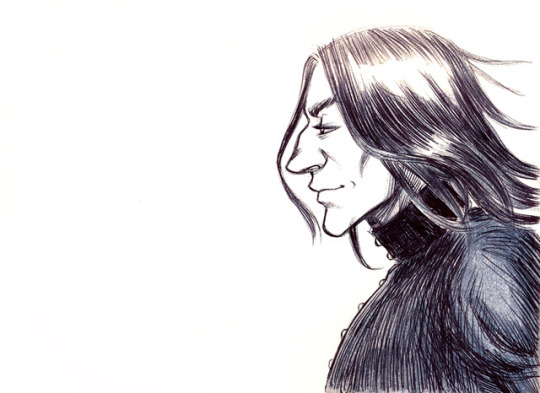
Made a wordless comic called Flight Plan for Snapecase 2018 (and Tumblr clearly hates it D: - WHAT A PAIN to put the panels in the right order, they kept jumping around).
Hope you enjoy it :).
2K notes
·
View notes


